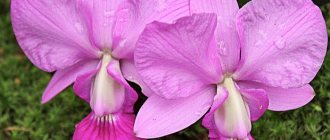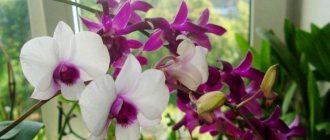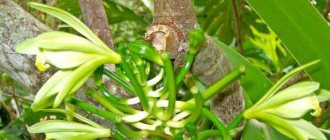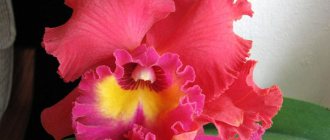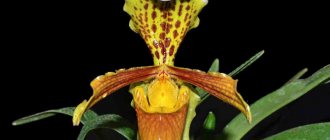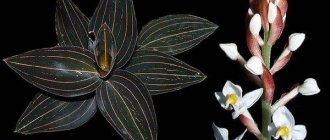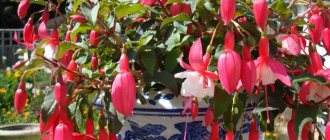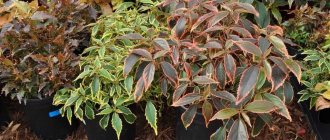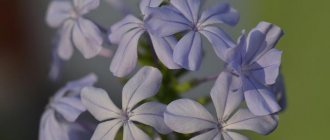In order for the odontoglossum to charm you with flowering, you will need create optimal conditions for it growths that will be most similar to natural ones.
To do this, the gardener must be theoretically savvy and know the strengths and weaknesses of a particular plant.
If this is not done, and if cultivation is neglected, then the orchid will not only not bloom, but may also die. You should be especially careful with capricious species . Let's find out in more detail what the Odontoglossum orchid looks like: its description, photo and care at home.
Short description
The odontoglossum orchid is becoming a very popular plant in indoor and greenhouse floriculture due to its ease of cultivation and long flower stalks, which often produce many impressive small flowers. In the photo you can see the Odontoglossum orchid.
Odontoglossum orchids are becoming more popular among amateur gardeners.
The plant genus is very polymorphic. The plant itself is medium to large in size, with closely spaced, flattened pseudobulbs. The leaves are leathery or soft, juicy. Flowers have:
- Various, unique colors;
- And a pleasant aroma.
They usually bloom once a year. Many odontoglossums have been linked by breeders through hybridization with other related orchids , such as Oncidiums. The goal of these processes is to produce more color variations and patterns, as well as strengthen the plant's resistance and immune system.
Location and support
This type of orchid requires shading during the hours of maximum solar activity: soft morning or evening sunlight is most favorable for it. The container with the plant should be at the level of the windowsill (in no case lower).
Miltonia leaves are very sensitive to sunlight. If there is too much of it, they turn yellow. If it’s not enough, they turn red. Light green leaves with a slight pinkish tint indicate proper lighting.
Miltonia prefers a high level of substrate humidity. Place the pot on a tray of damp tufa or place a humidifier near the plant. Attach the peduncle to the support using a special clip - place it a few centimeters below the flower.
Most common colors
Flowers can come in a variety of shapes and shades. The most common plants found are :
- With whites;
- Red;
- Purple;
- Brown;
- And yellow flowers.
They can also be painted with a mixture of several colors and have a design or pattern.
Irrigation regime when growing odontoglossum
Odontoglossums, in general, love watering. But the frequency and abundance of irrigation must be coordinated with the growing season in which the plant is:
| Rest phase | Peduncle extension phase | Flowering phase | New pseudobulb growth phase |
| Watering is rare, scanty, with good drying. The appearance of light wrinkles on pseudobulbs is allowed. | Watering abundantly, without completely drying the substrate. It is allowed to soak the pots in water for 15-20 minutes to ensure that the soil is well saturated with water. | Watering is frequent, moderate, without drying, through a watering can. | Watering frequently, without complete drying. The appearance of wrinkles on pseudobulbs is not allowed. |
Thus, the plant needs the most abundant watering after leaving the dormant phase. Subsequently, irrigation becomes regular but moderate. The substrate should not be over-moistened, but there is no need to allow the roots to dry out too much.
Sometimes odontoglossums exhibit the phenomenon of leaf harmonization. It occurs if, during the period of growth of a young pseudobulb, watering was insufficient, the temperature was high, and the air humidity was too low.
In the active phases of the orchid's life cycle, compliance with the irrigation regime is especially important.
Botanical characteristics
The genus contains about a hundred species of odontoglossums, not counting hybrid varieties. The name comes from the Greek odon (tooth) and glossa (tongue), referring to the two tooth-like projections at the base of the lip. As noted at the beginning of the article, this cold-growing orchid can be found in the mountainous regions of Central and South America.
Most plants are medium to large in size :
- Sympodial epiphytes;
- Lithophytes;
- Terrestrial plant species with short roots are rare.
Pseudobulbs are compact in size, slightly flattened with leafy bracts at the base . One bulb produces from one to three apical leaves.
Attention! Older pseudobulbs will lose their leaves over time but remain plump. They retain water and provide support for younger and growing pseudobulbs.
Leaves can be :
The Odontoglossum orchid can grow several flower stalks.
- Leathery;
- Or soft and juicy.
A peduncle grows from the base of the leaf , which can be straight or curved. There may be several peduncles and they may branch. Its length varies from species to species.
One plant can have a peduncle :
- Long - bear up to 150 flowers;
- Another has a short one with 20-30 flowers.
The flowers come in a wide variety of shapes and colors, up to 5-6 cm in diameter. The lip is quite complex, whole or with three lobes. Flowers found :
- Red;
- Yellow;
- Purple;
- As well as other colors and combinations.
Popular types: photos and descriptions
Let us dwell in more detail on the most famous species of Odontoglossum.
Bictonian (O. bictoniense)
A medium-sized plant with narrowed petals. The flower is shaped like a five-pointed star with dark spots or streaks. The leaves are much lighter than those of the standard representative of the genus.
Pretty (O. pulchellum)
What makes the plant “pretty” is its snow-white color and the shape of its petals, similar to angel wings. Peduncles are arranged closely and lushly. The lip is shaped like a simple petal, but at the base there is a yellowish formation.
Crispum (O. Crispum)
The uniqueness of the orchid is emphasized by absolutely all parts: from the stems and emerald leaves to the inflorescences that look like white scarves. The shape of the petals is wavy. The lip is associated with a butterfly landing on a flower to drink nectar.
Lemon (O. citrosmum)
The flowers of the plant resemble those of phalaenopsis, but they are presented in greater numbers and are smaller in size. Petals are white or lilac. Orchids only got their name from lemons.
Heart-shaped (O. cordatum)
Ampelous long flower stalks literally hang from the plant. There are purple spots on the yellow background of the flowers. The white, heart-shaped lip has small burgundy flecks.
Large (O. grande)
The second name is tiger. The species is distinguished from all others by its impressive dimensions; most often it can be found in tropical forests. The buds are bright yellow with brown stripes. The lip has the shape of an inverted peacock tail and is colored light or bright yellow with pink or red splashes.
This is a rhizomatous plant, although its root cannot be immediately seen, since it is hidden behind the pseudobulbs.
Spotted (O. blandum)
Brown spots are “painted” on chestnut or lemon inflorescences. The petals are light lemon-colored and tilted over a large lip with a yellow spot. There is a massive creamy growth at the base.
Features of flowering
Odontoglossum prefers to bloom every nine to ten months , from late winter to early summer, around February-March. In indoor conditions it can bloom in May-June. Flowering lasts about six weeks.
Stimulation
You can stimulate flowering by keeping the orchid dry (without watering for a month), while creating a significant temperature difference between day and night (5-6 °C).
Stimulating flowering using this method should be carried out only if the plant’s appearance indicates that it is ready to bloom: it is well-fed and healthy. Then you can give him a little push.
Attention! You should not stimulate flowering in odontoglossum if the grower lacks experience, or if the plant was transplanted, was sick, or was subjected to any other influences that could provoke stress. Depletion and weakening of the plant can lead to illness, and in the worst case, to the death of the specimen. Be careful.
Reproduction with step-by-step photos
Propagated by dividing the bush. It is better to carry out the procedure during transplantation, so as not to further injure the plant. The roots are cut with a sterile instrument.
Each division should have two or three young bulbs.
Divisions ready for planting
Planted in small pots.
After being placed in the substrate, young plants are not watered for three days, but the leaves need to be sprayed.
You can learn about diseases and pests of orchids from this article.
Author: Yulia Zakrevskaya Updated: March 31, 2020
- All about orchids
Comments
Julia 05/28/2017 11:57 Beautiful!
Answer
Update list of comments
Growing conditions and care
Lighting
Caring for an orchid at home requires painstaking and very careful work. Odontoglossum prefers moderate light , but this does not mean that it should grow in the shade all year round. It is best to place the plant where light can reach it but not burn it. The best location would be a meter from the western or eastern window.
On the south window, place the plant in the back of the room, and on the north window you can place it directly on the windowsill. At midday, especially on hot summer days, the plant should be covered (shaded) from the bright sun.
The Odontoglossum orchid should not be exposed to direct sunlight.
Artificial lighting will be the best friend of the odontoglossum, since, unlike the sun, you can control the intensity of the lamp yourself .
Greenhouses and similar structures (florariums) are also the best places to place these orchids, since sunlight can be filtered to some extent to a certain extent. Never place odontoglossum in direct sun - the leaves will get sunburned . The yellow-green color of the leaf is an ideal sign of optimal lighting.
Watering and humidity
Like most types of orchids, odontoglossums need to be watered once or twice a week depending on the weather. If the temperature is higher, more frequent and abundant watering is required, and vice versa when the temperature drops.
Advice! The only thing you should pay attention to is the growth of new pseudobulbs. When the young bulb begins to grow, increase watering and return to the weekly watering rule once it is fully formed.
The air humidity level should be from 50% to 70%, but not lower than 40%, otherwise the odontoglossum will dry out . To maintain an optimal level of humidity, orchids can be sprayed with settled or rainwater in the morning; try not to let droplets of moisture fall on the flowers.
Also place a tray with pebbles or expanded clay and water at the base of the orchid pot, but so that the bottom of the pot does not touch the water. The best solution would be to purchase an air humidifier or place the plant in a florarium.
Temperature
Odontoglossums are orchids that prefer cooler temperatures . The reason for this is that in the wild they grow:
- In the high Andes mountains;
- And the cool forests of Central and South America.
During the day, the ideal temperature would be between 15 and 27 °C. These plants can withstand warmer and colder temperatures, but not for very long. If they remain in these conditions, the flowers may not bloom or may even wither and fall off.
Always remember to provide adequate air circulation because they love fresh air, similar to plants in their natural habitat.
Feeding and fertilizer
Odontoglossums should be fed at least once a month. It is preferable to use special fertilizers for orchids in half the recommended dosage. Do not feed the plant!
Before fertilizing, it is necessary to moisten the root system of the plant. If this is not done, you may accidentally burn the roots or young shoots. Once a month, dry the container with the flower to remove any remaining salt deposits.
Important! During flowering, fertilizing is not carried out.
After flowering and during the dormant period
Odontoglossum is a tropical plant and does not have a dormant period as such. However, a conditional dormant period can be considered the time period from March to August, when the plant is actively vegetating and growing green mass. At this time, it is watered and fed abundantly.
Conditions of detention
Illumination
Odontoglossum is a light-loving orchid and needs good lighting, but it should be protected from direct sunlight.
Temperature
Odontoglossum is adapted to cool temperatures, but hybrids created by crossing with heat-loving species are adapted to normal room temperature.
In summer it is recommended to keep it at a temperature of 24 to 26 degrees.
In winter from 13 to 17 degrees.
Reviews
Oksana, Moscow: “ Spectacular in its beauty and very interesting orchid, which pleases with its flowers even in winter. It has been growing with me for several years now and, as it lives, it reproduces itself, so to speak. For some time I was worried that the old bulbs would die and my odontoglossum would die. But I soon became convinced that the bulbs grow faster than they die, and they can even be replanted as needed.
Amateur flower growers really like the Odontoglossum orchid for its extraordinary flowering.
I want to say that I came across a rather capricious specimen that requires attention to itself, but when it blooms, I understand that all my efforts are justified. The plant produces simply incredible flowers. Thanks, probably. That's how we live."
Boris, Rostov-on-Don: “ I have long wanted to diversify my orchid collection with something truly exquisite. I acquired a yellow odontoglossum with red spots. The coloring can be said to be aggressive, almost combative. Immediately attracts attention. The flowers, however, are small and do not last long, but they are not like others. The aroma can be a little annoying if the room is not ventilated, but overall it is pleasant and works well as an air freshener. Guests are immediately surprised when they enter the apartment, and everyone immediately wants to know what it smells like. Regarding care, I have been growing orchids for a long time and the flower has not caused any difficulties in caring for it. It is enough to provide him with the necessary conditions and maintain them.”
Snezhana, Kharkov: “ I had doubts about the purchase, because I was not confident in my abilities and capabilities to care for such beauty. However, my curiosity got the better of me and, to my surprise, it turned out that my odontoglossum, which I received in the mail, is no more picky than an ordinary store-bought phalaenopsis. Watching my handsome man, I realized that he loves fresh air and coolness, and prefers diffused light to bright light.
Sometimes I give my orchids a preventive measure - I bathe them in the shower, which they respond well to. This is especially noticeable on hot days, when the orchids really come to life after bathing.
Another thing I noticed, perhaps, is that the only difference between the odontoglossum and my phalics is that it is demanding of air humidity. Of course, it can adapt, but how great the plant looks, even without flowers, when you spray it regularly.”
Veronica, St. Petersburg: “ This is a wonderful gift, I was delighted when I first saw this beauty. It’s like the sun on a windowsill on a cloudy day - you look and your soul rejoices. Now I’m studying literature about my flower. I already understand that it will not be easy, but no one told me that it would be easy! I would like to buy a few more similar orchids. I am infinitely happy and grateful to my beloved.”
1.Seven secrets of success:
| 1. Growing temperature: The maintenance temperature will depend not on the time of year, but on the stage of development of the plant. During the period of pseudobulb formation, dendrobium is kept at temperature swings - warm during the day and cool at night. After the pseudobulbs are formed, the orchid is placed in a consistently warm place with a temperature of about 8 degrees Celsius. To form buds, plants will also need daily temperature changes. During the dormant period, which begins immediately after flowering, create a cool environment around the pot within 15 - 16 degrees Celsius. |
| 2. Lighting: A brightly lit location with plenty of reflected sunlight. For the formation of buds, long daylight hours of about 14 hours daily are very important. |
| 3. Watering and air humidity: the frequency of watering will depend on the temperature of the content and the stage of development of the flower. Between waterings, the top layer of the substrate is usually dried to a depth of several centimeters. The flower is very sensitive to water quality - use only soft water at room temperature for watering. Air humidity is high. |
| 4. Features: For beginning flower growers, varieties of dendrobium are suitable for cultivation, which can be kept throughout the year at normal room temperature. |
| 5. Soil: the flower is grown in a coarse-fiber orchid mixture that is highly permeable to moisture and air, which may consist of sphagnum moss, pieces of pine bark, pine needles, fern fibers, coconut fiber. The soil should have a slightly acidic pH. |
| 6. Feeding: during the growth period and during flowering, fertilizers for orchids are regularly applied - 2 times a month. During the dormant period, plants are not fed. |
| 7. Reproduction: propagated by division during spring transplantation, stem cuttings, and much less often by sowing seeds. |
Botanical name: Dendrobium.
Family
Dendrobium orchid - origin. The plants are native to India, Asia, Australia, New Zealand, and the Pacific Islands.
Description. The genus Dendrobium includes about 900 species of deciduous or evergreen orchids. The species are extremely diverse and can behave in nature as epiphytes and lithophytes.
The pseudobulbs of the plants are thick, juicy, as if they consist of individual segments.
The leaves are belt-shaped or oblong-ovate, leathery, alternate. Inflorescences - racemes are located in the axils of the leaves along the pseudobulbs, are very numerous and sometimes almost hide the foliage.
The flowers range from tiny to quite large - up to 10 cm in diameter, in a wide variety of shades - yellow, orange, red, pink, green, blue, purple, white, except perhaps black.
There are two-color varieties, and dendrobiums that often bloom have a pleasant aroma.
Despite the fact that this orchid has been known since the 18th century, it gained real popularity only in 1967, when it was first propagated in the laboratory and varieties suitable for growing at home appeared.
Height. Depends on the type and can range from 15 to 75 cm, some orchids can reach 1 m in height.
Planting, transplanting and propagation
These orchids are mainly classified as epiphytes. So the best option for them would be to fix them on a block or plant them in the bark of coniferous plants.
Use smaller containers and a medium or fine substrate. Smaller pots are more practical , since the root system of the odontoglossum prefers close quarters.
Planting a plant will not cause any difficulties :
- Fill the pot 1/3 full with substrate;
- Place the plant in the pot;
- Gently distribute the roots;
- Fill the remaining voids with substrate.
Odontoglossums must be replanted at least once a year. Remove the old mixture and trim off any dead roots. At home, odontoglossum reproduces, like all sympodial orchids. You can verify the transplantation and division by checking whether the new shoot has grown 5-10 cm in height.
You can replant and plant if 3-5 young pseudobulbs have grown. After transplanting, water the plant sparingly until the roots begin to grow, then return to regular watering .
Plant propagation
Odontoglossum: photo of an orchid
The best time for Odontoglossum reproduction will not be any specific time of year or month, but absolutely any moment. However, believe me, it is much easier and more convenient to carry out this operation when the flower is transplanted. Thus, you, let's say, kill two birds with one stone. As for propagation methods, the most effective of them is, perhaps, the division method, since it not only shows a remarkable survival rate, but is also incredibly easy to learn and perform. The most important thing is to divide the plant only if it has more than six formed pseudobulbs, since only then will you be able to ensure the presence of at least three pseudobulbs in each plot.
Well, of course, it’s not even worth mentioning that the entire operation is carried out with extreme caution and with tools specially created for it.
After dividing the Odontoglossum, the damaged areas should be treated with crushed charcoal, as they are incredibly vulnerable to viruses and bacteria. After disinfection, you can begin preparing the plots for planting. To do this, you should first lay them on very finely chopped moss and keep them in this state until new roots begin to appear. Once this begins to happen, the plots can be planted in separate pots and cared for as full-fledged plants.
Main growing problems
Yellowish leaves mean the plant needs less light, while dark green leaves mean it needs more. The main problem is rotting of the root system due to flooding of the plant. This often leads to the death of the plant.
Another nuisance is the low level of humidity in apartments. Low air humidity can be detrimental not only to odontoglossum, but also to other tropical plants. This is especially dangerous in winter, when the heating is turned on and air humidity drops sharply to 30%.
Expert advice on growing odontoglossums on blocks
If desired and with certain skill, odontoglossums can be grown not only in the usual way, in pots, but also on blocks:
“Odontoglossums look good and feel great on blocks. In my orchidarium, I often divide them, and there is no longer enough space for pots, but growing them this way saves a lot of space. Planting is carried out as usual - a ball of fern roots is placed under the orchid, and the plant is secured with twine. Lately I’ve been using oak wood for blocks, as it rots and crumbles less than pine. I also recommend this method because orchids never have root rot on blocks. The main thing is to monitor the air humidity.”
M. Lenkova, orchid collector with 17 years of experience
Growing on wooden blocks helps create conditions for orchids that are as close to natural as possible.
Diseases and pests
Affected by pests such as:
- Spider mite;
- Mealybug;
- Shchitovka.
If a plant is damaged by insects, complex insecticides should be used in the dosage indicated on the package. To combat diseases, fungi and rot, use fungicides . If a plant is damaged by a viral infection, it is disposed of .
Prevention
The best prevention is to maintain the health of the plant and keep it in normal conditions . The healthier it is, the less likely it is to be affected by disease or insects.
Features of the morphology and physiology of shade-tolerant plants
Shade-tolerant plants are characterized by a relatively low intensity of photosynthesis. Their leaves differ from the leaves of heliophytes in a number of important anatomical and morphological characteristics. In the leaves of shade-tolerant plants, columnar and spongy parenchyma are usually poorly differentiated; characterized by increased intercellular spaces. The epidermis is quite thin, single-layered; epidermal cells may contain chloroplasts (which is never found in heliophytes). The cuticle is usually thin. Stomata are usually located on both sides of the leaf with a slight predominance on the reverse side (in light-loving plants, as a rule, there are no stomata on the front side or are located predominantly on the reverse side). Compared to heliophytes, shade-tolerant plants have a significantly lower content of chloroplasts in leaf cells - on average from 10 to 40 per cell; the total surface of the leaf chloroplasts does not significantly exceed its area (2-6 times; whereas in heliophytes the excess is tens of times).
Some shade-tolerant plants are characterized by the formation of anthocyanin in cells when growing in bright sun, which gives a reddish or brownish color to the leaves and stems, which is uncharacteristic in natural habitat conditions. Others have paler leaves when grown in direct sunlight.
The appearance of shade-tolerant plants also differs from light-loving ones. Shade-tolerant plants typically have wider, thinner and softer leaves to capture more indirect sunlight. They are usually flat and smooth in shape (whereas in heliophytes, folding and tuberculation of leaves is often found). Characterized by a horizontal arrangement of foliage (in heliophytes, leaves are often located at an angle to the light) and a leaf mosaic. Forest herbs are usually elongated, tall, and have an elongated stem.
Many shade-tolerant plants have high plasticity of their anatomical structure depending on the light level (primarily this concerns the structure of the leaves). For example, in beech, lilac, and oak, leaves formed in the shade usually have significant anatomical differences from leaves grown in bright sunlight. The latter in their structure resemble the leaves of heliophytes (such leaves are defined as “light”, as opposed to “shadow”).
Features of cultivation, choice of location for heliophyte
All plants need three things to continue their life - the supply of light, water and heat, but to a greater or lesser extent.
Typical examples of light-loving plants can be given even without special knowledge - each of them has certain specific characteristics:
- small leaves with a rough texture, which help reduce the evaporation of the resulting moisture;
- hairs or waxy coating, which are provided by nature for the same purposes - water conservation and protection of cells from intense ultraviolet radiation;
- basal metabolism and carotenoids are not the signs that help an amateur gardener distinguish a heliophyte from a sciophyte, but those listed earlier are quite enough to distinguish them by their ability to adapt.
There are several species criteria for a light-loving plant that cannot be taken into account when purchasing seeds. It is difficult to distinguish a facultative heliophyte from one more adapted to the sun, and this must be done before planting in the ground in order to intelligently distribute the plants according to the degree of illumination.
Therefore, in your free time from working in the garden, it is better to study the available information, look for it on special sites and draw up a plan for the approximate location of plantings even before purchasing seeds, sowing seedlings and planting in open ground. The main differences between heliophytes and sciophytes are listed here:
Odontoglossum – Cambria
It grows in the Andes at an altitude of 2000-3000 m above sea level and does not like high air temperatures. This orchid adapts well to home conditions if it is kept cool at night. Large, sometimes branched peduncles and bright flowers make these orchids extremely attractive.
- Temperature: 20-25 °C during the day, 12-16 °C at night
- Daily temperature changes: 8-10 °C
- Flowering duration: 4-8 weeks
- Flowering time: not tied to seasons
- Flowering frequency: variable
- Flower color: pink, yellow, red, brown, lilac, purple
- Location: window facing east or west
- Growth type: sympodial with thick round, ovoid or pear-shaped pseudobulbs
Feeding odontoglossum: fertilizers and schemes
Just like watering, fertilizing odontoglassum is carried out in the active phase of vegetative growth - while the peduncle is growing and a young pseudobulb is forming. During the dormant and flowering periods, orchids do not need fertilizers.
Feeding requires liquid fertilizers, the compositions of which are designed specifically for orchids. They are characterized by a low concentration of salts, so the risk of overdose, chemical burn of the roots or salting of the substrate is eliminated when properly diluted.
The following types of fertilizers can be used to feed odontoglossums:
- During the growth period of the peduncle - “Agricola for orchids”, “Pokon for orchids”, “Doctor Foley Orchid”. Diluted according to instructions and used no more than once every 2 weeks until the first bud opens.
- During the period of pseudobulb growth - “Bona Forte for orchids”, “Agrecol for orchids”. Diluted according to instructions and applied once every 2 weeks until new growth has fully matured.
The basic rule for feeding odontoglossums is more phosphorus during the period of peduncle growth and a balance of nitrogen and potassium during the period of pseudobulb growth.
When feeding odontoglossums, you should not overuse fertilizers with a high nitrogen content. Their use leads to a deterioration in the quality of flowering.
